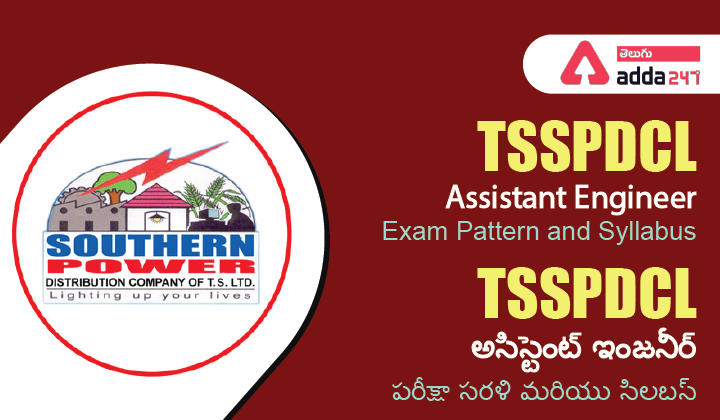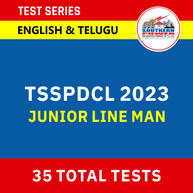TSSPDCL Assistant Engineer Syllabus: Southern Power Distribution Company of Telangana Limited has released the TSSPDCL Assistant Engineer Syllabus along with the TSSPDCL Assistant Engineer(Electrical) Notification 2023. Candidates who are going to appear for TSSPDCL Assistant Engineer Exam 2023 should know the TSSPDCL Assistant Engineer Syllabus and Exam Pattern 2023 well. Candidates can check the Syllabus of the TSSPDCL Assistant Engineer in this article. In this article, Aspirants get detailed information about the TSSPDCL Assistant Engineer Syllabus and Exam pattern
TSSPDCL Assistant Engineer Notification 2023
TSSPDCL Assistant Engineer Syllabus Overview
TSSPDCL అసిస్టెంట్ ఇంజనీర్/ఎలక్ట్రికల్ ఉద్యోగాల భర్తీకి 48 ఖాళీల కోసం నోటిఫికేషన్ విడుదల చేసింది. నోటిఫికేషన్ యొక్క పూర్తి సమాచారం కోసం దిగువ పట్టిక చుడండి
| TSSPDCL Assistant Engineer Syllabus 2023 | |
| Organization | Southern Power Distribution Company of Telangana Limited |
| Posts Name | Assistant Engineer (Electrical) |
| Vacancies | 48 |
| Category | Syllabus |
| Date of Examination | 30 April 2023 |
| Selection Process | Written Test |
| Job Location | Telangana State |
| Official Website | https://tssouthernpower.cgg.gov.in/ |
 APPSC/TSPSC Sure shot Selection Group
APPSC/TSPSC Sure shot Selection Group
TSSPDCL Assistant Engineer Exam Pattern and Syllabus
TSSPDCL Assistant Engineer Exam Pattern and Syllabus: TSSPDCL అసిస్టెంట్ ఇంజనీర్ పరీక్ష 30 ఏప్రిల్ 2023న నిర్వహించబడుతుంది. అభ్యర్థులు TSSPDCL అసిస్టెంట్ ఇంజనీర్ సిలబస్ మరియు పరీక్షా సరళి తెలుసుకోవడం ద్వారా తమ ప్రిపరేషన్ మరింత మెరుగ్గా ప్రారంభించవచ్చు. TSSPDCL అసిస్టెంట్ ఇంజనీర్ సిలబస్ మరియు పరీక్షా సరళి 2023 పూర్తి వివరాలు తెలుసుకోవాలంటే పూర్తి కథనం చదవాలి.
TSSPDCL Assistant Engineer Exam Date
TSSPDCL Assistant Engineer Exam Pattern | పరీక్షా విధానం
- TSSPDCL అసిస్టెంట్ ఇంజనీర్/ఎలక్ట్రికల్ వ్రాత పరీక్ష 100 మార్కులను కలిగి ఉంటుంది.
- ఇందులో 100 బహుళ ఎంపిక ప్రశ్నలు మరియు ప్రతి ప్రశ్నకు 1 మార్కు ఉంటుంది.
- సెక్షన్ Aలో కోర్ టెక్నికల్ సబ్జెక్ట్పై 80 ప్రశ్నలు ఉంటాయి
- సెక్షన్ Bలో తెలంగాణ సంస్కృతి & ఉద్యమానికి సంబంధించిన జనరల్ అవేర్నెస్ మరియు న్యూమరికల్ ఎబిలిటీ మరియు హిస్టరీపై 20 ప్రశ్నలు ఉంటాయి.
- రాత పరీక్ష వ్యవధి 2 గంటలు. (120 నిమిషాలు).
TSSPDCL Assistant Engineer Hall Ticket 2023
TSSPDCL AE Exam Pattern 2023 | TSSPDCL AE పరీక్షా విధానం
- కోర్ టెక్నికల్ సబ్జెక్ట్ – 80 ప్రశ్నలు – 80 మార్కులు.
- జనరల్ అవేర్నెస్ మరియు న్యూమరికల్ ఎబిలిటీ – 20 ప్రశ్నలు – 20 మార్కులు.
- మొత్తం ప్రశ్నలు – 100
- మొత్తం మార్కులు – 100.
- మొత్తం సమయం వ్యవధి – 2 గంటలు.
| TSSPDCL AE Exam Pattern 2023 | |||
|---|---|---|---|
| సబ్జెక్టు | ప్రశ్నల సంఖ్య | మార్కులు | వ్యవధి |
| టెక్నికల్ ఎబిలిటీ (ఎలక్ట్రికల్) | 80 | 80 | 2 గంటలు |
| జనరల్ అవేర్నెస్ మరియు న్యూమరికల్ ఎబిలిటీ | 20 | 20 | |
| మొత్తం | 100 | 100 | |
TSSPDCL Assistant Engineer Syllabus | TSSPDCL అసిస్టెంట్ ఇంజనీర్ సిలబస్
TSSPDCL అసిస్టెంట్ ఇంజనీర్/ఎలక్ట్రికల్ వ్రాత పరీక్ష 100 మార్కులను కలిగి ఉంటుంది. సెక్షన్ Aలో కోర్ టెక్నికల్ సబ్జెక్ట్పై 80 ప్రశ్నలు మరియు సెక్షన్ Bలో తెలంగాణ సంస్కృతి & ఉద్యమానికి సంబంధించిన జనరల్ అవేర్నెస్ మరియు న్యూమరికల్ ఎబిలిటీ మరియు హిస్టరీపై 20 ప్రశ్నలు ఉంటాయి. సెక్షన్ A మరియు సెక్షన్ B సంబంధించిన పూర్తి సిలబస్ వివరాలను దిగువన క్లుప్తంగా ఇచ్చాము .
Download TSSPDCL Assistant Engineer Syllabus pdf
TSSPDCL Assitant Engineer Section-A Syllabus: 80 Marks
1. Engineering Mathematics
Linear Algebra: Matrix Algebra, Systems of linear equations, Eigenvalues, Eigenvectors.
Calculus: Mean value theorems, Theorems of integral calculus, Evaluation of definite and improper integrals, Partial Derivatives, Maxima and minima, Multiple integrals, Fourier series, Vector identities, Directional derivatives, Line integral, Surface integral, Volume integral, Stokes’s theorem, Gauss’s theorem, Green’s theorem.
Differential equations: First-order equations (linear and nonlinear), Higher order linear differential equations with constant coefficients, Method of variation of parameters, Cauchy’s equation, Euler’s equation, Initial and boundary value problems, Partial Differential Equations, Method of separation of variables.
Complex variables: Analytic functions, Cauchy’s integral theorem, Cauchy’s integral formula, Taylor series, Laurent series, Residue theorem, Solution integrals.
Probability and Statistics: Sampling theorems, Conditional probability, Mean, Median, Mode, Standard Deviation, Random variables, Discrete and Continuous distributions, Poisson distribution, Normal distribution, Binomial distribution, Correlation analysis, and Regression analysis.
Numerical Methods: Solutions of nonlinear algebraic equations, Single and Multi‐step methods for differential equations.
Transform Theory: Fourier Transform, Laplace Transform, z‐Transform.
II. Electrical Engineering Electric Circuits
Network graph, KCL, KVL, Node and Mesh analysis, Transient response of dc and ac networks, Sinusoidal steady‐state analysis, Resonance, Passive filters, Ideal current and voltage sources, Thevenin’s theorem, Norton’s theorem, Superposition theorem, Maximum power transfer theorem, Two‐port networks, Three phase circuits, Power and power factor in ac circuits.
III. Electromagnetic Fields
Coulomb’s Law, Electric Field Intensity, Electric Flux Density, Gauss’s Law, Divergence, Electric field, and potential due to point, line, plane, and spherical charge distributions, Effect of the dielectric medium, Capacitance of simple configurations, Biot‐Savart’s law, Ampere’s law, Curl, Faraday’s law, Lorentz force, Inductance, Magnetomotive force, Reluctance, Magnetic circuits, Self and Mutual inductance of simple configurations.
IV. Signals and Systems
Representation of continuous and discrete‐time signals, Shifting and scaling operations, Linear Time Invariant and Causal systems, Fourier series representation of continuous periodic signals, Sampling theorem, Applications of Fourier Transform, Laplace Transform, and z-Transform.
V.Electrical Machines
Single phase transformer: equivalent circuit, phasor diagram, open circuit, and short circuit tests, regulation and efficiency; Three phase transformers: connections, parallel operation; Auto‐transformer, Electromechanical energy conversion principles, DC machines: separately excited, series and shunt, motoring and generating mode of operation and their characteristics, starting and speed control of dc motors; Three phase induction motors: the principle of operation, types, performance, torque-speed characteristics, no-load and blocked rotor tests, equivalent circuit, starting and speed control; Operating principle of single phase induction motors; Synchronous machines: cylindrical and salient pole machines, performance, regulation and parallel operation of generators, starting of synchronous motor, characteristics; Types of losses and efficiency calculations of electric machines.
VI. Power Systems
Power generation concepts, ac and dc transmission concepts, Models and performance of transmission lines and cables, Series and shunt compensation, Electric field distribution and insulators, Distribution systems, Per‐unit quantities, Bus admittance matrix, Gauss-Seidel and Newton-Raphson load flow methods, Voltage and Frequency control, Power factor correction, Symmetrical components, Symmetrical and unsymmetrical fault analysis, Principles of over‐current, differential and distance protection; Circuit breakers, System stability concepts, Equal area criterion.
VII. Control Systems
Mathematical modeling and representation of systems, Feedback principle, transfer function, Block diagrams and Signal flow graphs, Transient and Steady‐state analysis of linear time-invariant systems, Routh-Hurwitz and Nyquist criteria, Bode plots, Root loci, Stability analysis, Lag, Lead and Lead‐Lag compensators; P, PI and PID controllers; State space model, State transition matrix.
VIII. Electrical and Electronic Measurements
Bridges and Potentiometers, Measurement of voltage, current, power, energy, and power factor; Instrument transformers, Digital voltmeters, and multimeters, Phase, Time, and Frequency measurement; Oscilloscopes, Error analysis.
IX. Analog and Digital Electronics
Characteristics of diodes, BJT, MOSFET; Simple diode circuits: clipping, clamping, rectifiers; Amplifiers: Biasing, Equivalent circuit and Frequency response; Oscillators and Feedback amplifiers; Operational amplifiers: Characteristics and applications; Simple active filters, VCOs and Timers, Combinational and Sequential logic circuits, Multiplexer, Demultiplexer, Schmitt trigger, Sample and hold circuits, A/D and D/A converters, 8085Microprocessor: Architecture, Programming, and Interfacing.
X. Power Electronics
Characteristics of semiconductor power devices: Diode, Thyristor, Triac, GTO, MOSFET, IGBT; DC to DC conversion: Buck, Boost, and Buck-Boost converters; Single and three phase configuration of uncontrolled rectifiers, Line commutated thyristor-based converters, Bidirectional ac to dc voltage source converters, Issues of line current harmonics, Power factor, Distortion factor of ac to dc converters, Single phase and three phase inverters, Sinusoidal pulse width modulation.
TSSPDCL Assistant Engineer Section-B Syllabus: 20 Marks
General Awareness and Numerical Ability :
- Analytical & Numerical Ability
- General Awareness
- English
- Related to Telangana Culture & Movement and v) Computer Knowledge
TSSPDCL Assistant Engineer Minimum Qualifying Marks | కనీస అర్హత మార్కులు
TSSPDCL అసిస్టెంట్ ఇంజనీర్/ఎలక్ట్రికల్ ఎంపిక ప్రక్రియ కోసం వ్రాత పరీక్షలో కనీస అర్హత మార్కులు క్రింది విధంగా ఉంటాయి
| Category | Qualifying Marks |
| OC & EWS | 40% |
| BC | 35% |
| SC/ST | 30% |
| PH | 30% |
TSSPDCL Assistant Engineer Eligibility Criteria 2023
********************************************************************************************
| మరింత చదవండి: |
|
| తాజా ఉద్యోగ ప్రకటనలు | ఇక్కడ క్లిక్ చేయండి |
| ఉచిత స్టడీ మెటీరియల్ (APPSC, TSPSC) | ఇక్కడ క్లిక్ చేయండి |
| ఉచిత మాక్ టెస్టులు | ఇక్కడ క్లిక్ చేయండి |




